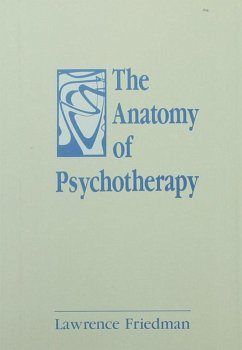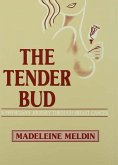Lawrence Friedman
The Anatomy of Psychotherapy (eBook, PDF)
45,95 €
45,95 €
inkl. MwSt.
Sofort per Download lieferbar

23 °P sammeln
45,95 €
Als Download kaufen

45,95 €
inkl. MwSt.
Sofort per Download lieferbar

23 °P sammeln
Jetzt verschenken
Alle Infos zum eBook verschenken
45,95 €
inkl. MwSt.
Sofort per Download lieferbar
Alle Infos zum eBook verschenken

23 °P sammeln
Lawrence Friedman
The Anatomy of Psychotherapy (eBook, PDF)
- Format: PDF
- Merkliste
- Auf die Merkliste
- Bewerten Bewerten
- Teilen
- Produkt teilen
- Produkterinnerung
- Produkterinnerung

Bitte loggen Sie sich zunächst in Ihr Kundenkonto ein oder registrieren Sie sich bei
bücher.de, um das eBook-Abo tolino select nutzen zu können.
Hier können Sie sich einloggen
Hier können Sie sich einloggen
Sie sind bereits eingeloggt. Klicken Sie auf 2. tolino select Abo, um fortzufahren.

Bitte loggen Sie sich zunächst in Ihr Kundenkonto ein oder registrieren Sie sich bei bücher.de, um das eBook-Abo tolino select nutzen zu können.
In this brilliant examination of how the therapist makes use of theories and styles in order to achieve equilibrium under stress, Lawrence Friedman probes the subtle interplay of theory and practice and offers penetrating assessments of recent theories o
- Geräte: PC
- mit Kopierschutz
- eBook Hilfe
- Größe: 12.57MB
Andere Kunden interessierten sich auch für
![The Therapist as a Person (eBook, PDF) The Therapist as a Person (eBook, PDF)]() The Therapist as a Person (eBook, PDF)54,95 €
The Therapist as a Person (eBook, PDF)54,95 €![Understanding Countertransference (eBook, PDF) Understanding Countertransference (eBook, PDF)]() Michael J. TanseyUnderstanding Countertransference (eBook, PDF)45,95 €
Michael J. TanseyUnderstanding Countertransference (eBook, PDF)45,95 €![Who's That Girl? Who's That Boy? (eBook, PDF) Who's That Girl? Who's That Boy? (eBook, PDF)]() Lynne LaytonWho's That Girl? Who's That Boy? (eBook, PDF)49,95 €
Lynne LaytonWho's That Girl? Who's That Boy? (eBook, PDF)49,95 €![The Analyst's Preconscious (eBook, PDF) The Analyst's Preconscious (eBook, PDF)]() Victoria HamiltonThe Analyst's Preconscious (eBook, PDF)46,95 €
Victoria HamiltonThe Analyst's Preconscious (eBook, PDF)46,95 €![The Psychology of Today's Woman (eBook, PDF) The Psychology of Today's Woman (eBook, PDF)]() The Psychology of Today's Woman (eBook, PDF)37,95 €
The Psychology of Today's Woman (eBook, PDF)37,95 €![The Tender Bud (eBook, PDF) The Tender Bud (eBook, PDF)]() Madeleine MeldinThe Tender Bud (eBook, PDF)23,95 €
Madeleine MeldinThe Tender Bud (eBook, PDF)23,95 €![Crime as Destiny (eBook, PDF) Crime as Destiny (eBook, PDF)]() Johannes LangeCrime as Destiny (eBook, PDF)31,95 €
Johannes LangeCrime as Destiny (eBook, PDF)31,95 €-
-
-
In this brilliant examination of how the therapist makes use of theories and styles in order to achieve equilibrium under stress, Lawrence Friedman probes the subtle interplay of theory and practice and offers penetrating assessments of recent theories o
Dieser Download kann aus rechtlichen Gründen nur mit Rechnungsadresse in A, B, BG, CY, CZ, D, DK, EW, E, FIN, F, GR, HR, H, IRL, I, LT, L, LR, M, NL, PL, P, R, S, SLO, SK ausgeliefert werden.
Produktdetails
- Produktdetails
- Verlag: Taylor & Francis eBooks
- Seitenzahl: 616
- Erscheinungstermin: 13. Mai 2013
- Englisch
- ISBN-13: 9781134877102
- Artikelnr.: 39265292
- Verlag: Taylor & Francis eBooks
- Seitenzahl: 616
- Erscheinungstermin: 13. Mai 2013
- Englisch
- ISBN-13: 9781134877102
- Artikelnr.: 39265292
- Herstellerkennzeichnung Die Herstellerinformationen sind derzeit nicht verfügbar.
Lawrence Friedman, M.D., is Clinical Professor of Psychiatry and a member of the History of Psychiatry section of the Department of Psychiatry, Cornell University Medical College. Dr. Friedman is the 1985 recipient of the American Psychoanalytic Association's Distinguished Contributor Award.
I. Theory and Practice: The Trouble with Psychotherapy 1. Whatever
Happened to the Therapist's Discomfort? 2. Discomfort Reflected in Theory:
The Therapeutic Alliance 3. Looking to Theory for Help 4. Descriptive
Help from Theory: Trends in the Psychoanalytic Theory of Treatment 5.
Other Uses of Theory 6. Overview II. Practice Observed 7. Leaving Theory
Temporarily 8. What Moves the Therapist? 9. Therapy Tasks that Theoy Must
Explain 10. Therapy Tasks: How the Therapist Makes Sense of the Patient
11. Therapy Tasks: How the Patient Makes Sense of the Therapist III.
Theory of the Mind: The Tool of Psychotherapy 12. Why Bother with Theory
of the Mind? 13. The Historical Context 14. Freud's Foothold 15.
Constructions of Freud's Paradigmatic Theory 16. Conclusion: The Nature
and Function of a Theory of the Mind IV. Debate About Theory of the Mind:
Revisions 17. Introduction 18. Peterfreund's Information-Processing
Theory 19. Phenomenological Theory: Mind as a World of Representations
20. Schafer's Action Language 21. Levenson's Perspectivism 22. Gendlin's
Vitalism 23. George Klein's Equilibrium Theory 24. Piaget's General
Project 25. Piaget and Psychotherapy 26. Kohut's Mixed Theory 27. The
Common Thread: Holism 28. Summary: The Need to Balance Perception and
Influence V. What is a Psychotherapist 29. Ambiguity as a Discipline 30.
Disambiguating Postures: General Considerations 31. Disambiguating
Postures: The Reading Imperative 32. Disambiguating Postures: The
Therapist's Historicism 33. Disambiguating Postures: The Therapist as
Operator 34. How It Fits Together: Performable Model and Metaphor VI.
Implications 35. Conclusion: No Resting Place 36. Training 37. The
Future
Happened to the Therapist's Discomfort? 2. Discomfort Reflected in Theory:
The Therapeutic Alliance 3. Looking to Theory for Help 4. Descriptive
Help from Theory: Trends in the Psychoanalytic Theory of Treatment 5.
Other Uses of Theory 6. Overview II. Practice Observed 7. Leaving Theory
Temporarily 8. What Moves the Therapist? 9. Therapy Tasks that Theoy Must
Explain 10. Therapy Tasks: How the Therapist Makes Sense of the Patient
11. Therapy Tasks: How the Patient Makes Sense of the Therapist III.
Theory of the Mind: The Tool of Psychotherapy 12. Why Bother with Theory
of the Mind? 13. The Historical Context 14. Freud's Foothold 15.
Constructions of Freud's Paradigmatic Theory 16. Conclusion: The Nature
and Function of a Theory of the Mind IV. Debate About Theory of the Mind:
Revisions 17. Introduction 18. Peterfreund's Information-Processing
Theory 19. Phenomenological Theory: Mind as a World of Representations
20. Schafer's Action Language 21. Levenson's Perspectivism 22. Gendlin's
Vitalism 23. George Klein's Equilibrium Theory 24. Piaget's General
Project 25. Piaget and Psychotherapy 26. Kohut's Mixed Theory 27. The
Common Thread: Holism 28. Summary: The Need to Balance Perception and
Influence V. What is a Psychotherapist 29. Ambiguity as a Discipline 30.
Disambiguating Postures: General Considerations 31. Disambiguating
Postures: The Reading Imperative 32. Disambiguating Postures: The
Therapist's Historicism 33. Disambiguating Postures: The Therapist as
Operator 34. How It Fits Together: Performable Model and Metaphor VI.
Implications 35. Conclusion: No Resting Place 36. Training 37. The
Future
I. Theory and Practice: The Trouble with Psychotherapy 1. Whatever
Happened to the Therapist's Discomfort? 2. Discomfort Reflected in Theory:
The Therapeutic Alliance 3. Looking to Theory for Help 4. Descriptive
Help from Theory: Trends in the Psychoanalytic Theory of Treatment 5.
Other Uses of Theory 6. Overview II. Practice Observed 7. Leaving Theory
Temporarily 8. What Moves the Therapist? 9. Therapy Tasks that Theoy Must
Explain 10. Therapy Tasks: How the Therapist Makes Sense of the Patient
11. Therapy Tasks: How the Patient Makes Sense of the Therapist III.
Theory of the Mind: The Tool of Psychotherapy 12. Why Bother with Theory
of the Mind? 13. The Historical Context 14. Freud's Foothold 15.
Constructions of Freud's Paradigmatic Theory 16. Conclusion: The Nature
and Function of a Theory of the Mind IV. Debate About Theory of the Mind:
Revisions 17. Introduction 18. Peterfreund's Information-Processing
Theory 19. Phenomenological Theory: Mind as a World of Representations
20. Schafer's Action Language 21. Levenson's Perspectivism 22. Gendlin's
Vitalism 23. George Klein's Equilibrium Theory 24. Piaget's General
Project 25. Piaget and Psychotherapy 26. Kohut's Mixed Theory 27. The
Common Thread: Holism 28. Summary: The Need to Balance Perception and
Influence V. What is a Psychotherapist 29. Ambiguity as a Discipline 30.
Disambiguating Postures: General Considerations 31. Disambiguating
Postures: The Reading Imperative 32. Disambiguating Postures: The
Therapist's Historicism 33. Disambiguating Postures: The Therapist as
Operator 34. How It Fits Together: Performable Model and Metaphor VI.
Implications 35. Conclusion: No Resting Place 36. Training 37. The
Future
Happened to the Therapist's Discomfort? 2. Discomfort Reflected in Theory:
The Therapeutic Alliance 3. Looking to Theory for Help 4. Descriptive
Help from Theory: Trends in the Psychoanalytic Theory of Treatment 5.
Other Uses of Theory 6. Overview II. Practice Observed 7. Leaving Theory
Temporarily 8. What Moves the Therapist? 9. Therapy Tasks that Theoy Must
Explain 10. Therapy Tasks: How the Therapist Makes Sense of the Patient
11. Therapy Tasks: How the Patient Makes Sense of the Therapist III.
Theory of the Mind: The Tool of Psychotherapy 12. Why Bother with Theory
of the Mind? 13. The Historical Context 14. Freud's Foothold 15.
Constructions of Freud's Paradigmatic Theory 16. Conclusion: The Nature
and Function of a Theory of the Mind IV. Debate About Theory of the Mind:
Revisions 17. Introduction 18. Peterfreund's Information-Processing
Theory 19. Phenomenological Theory: Mind as a World of Representations
20. Schafer's Action Language 21. Levenson's Perspectivism 22. Gendlin's
Vitalism 23. George Klein's Equilibrium Theory 24. Piaget's General
Project 25. Piaget and Psychotherapy 26. Kohut's Mixed Theory 27. The
Common Thread: Holism 28. Summary: The Need to Balance Perception and
Influence V. What is a Psychotherapist 29. Ambiguity as a Discipline 30.
Disambiguating Postures: General Considerations 31. Disambiguating
Postures: The Reading Imperative 32. Disambiguating Postures: The
Therapist's Historicism 33. Disambiguating Postures: The Therapist as
Operator 34. How It Fits Together: Performable Model and Metaphor VI.
Implications 35. Conclusion: No Resting Place 36. Training 37. The
Future







